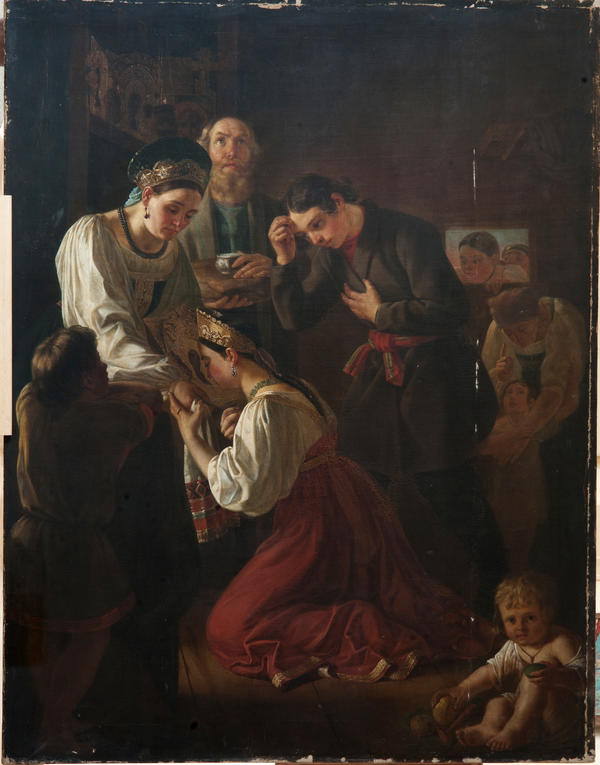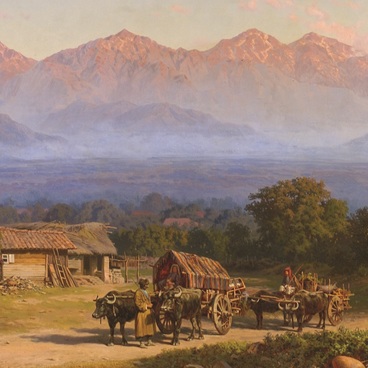Bleesing before Wedding was painted by an unknown Russian artist in the first third of the 19th century. It is a genre scene — the artist depicts a situation of everyday life of ordinary people and thus captures the reality surrounding him.
The subject of the painting is the beauty of a traditional ceremony. The artist has placed a multi-figured composition in a tight space of a room, choosing an upright format. The center of the painting are its main characters participating in the ceremony. In the traditional God’s corner, where the icons and the icon lamp are placed, parents with an icon and bread and salt in their hands are blessing the bride and the groom. This group is painted most prominently and carefully.
The artist is precise in the reproduction of costumes and headwear, emphasizing their non-everyday style. The mother is not wearing an everyday kika — a headdress of a married woman, rather she is wearing a smart kokoshnik (head band) that was worn on special occasions. The bride is wearing a maid’s crown. Both female characters are wearing pinafore dresses with inwrought border round the dresses and on the corsage, and both are wearing jewels. The groom is encircled with an elegant girdle. The embroidered edge of the wedding towel, the metal setting of the icon — objects that play a significant role in the traditional life — are delineated scrupulously.
The rest of the characters around them are in the shaded areas, they are wearing everyday clothes devoid of jewelry and trimmings. Each character in a painting and what they do is a character type or a lively genre scene, unlike the central group. In the foreground, a teenager is viewing the happenings with interest, and an inquisitive, lively child is sitting on the floor and looking at the viewer. In the back of the picture, an elderly woman is calling to order and preaching at another child, a little further there are curious children looking into a narrow window. The images of children painted by the artist are particularly attractive and genuine, the children do not disturb the loftiness and the dignity of the moment.
The artist aimed at capturing the ethnographic authenticity of the characters, but at the same time asserted the presence of poetic element in the traditional life. The peasant family on the canvas turned out to be romanticized which was quite in line with the traditions of sentimentalism, the Venetsianov genre school of national painting and the aesthetics of the Slavophiles, who spoke of a special original type of Orthodox Russian culture.
The subject of the painting is the beauty of a traditional ceremony. The artist has placed a multi-figured composition in a tight space of a room, choosing an upright format. The center of the painting are its main characters participating in the ceremony. In the traditional God’s corner, where the icons and the icon lamp are placed, parents with an icon and bread and salt in their hands are blessing the bride and the groom. This group is painted most prominently and carefully.
The artist is precise in the reproduction of costumes and headwear, emphasizing their non-everyday style. The mother is not wearing an everyday kika — a headdress of a married woman, rather she is wearing a smart kokoshnik (head band) that was worn on special occasions. The bride is wearing a maid’s crown. Both female characters are wearing pinafore dresses with inwrought border round the dresses and on the corsage, and both are wearing jewels. The groom is encircled with an elegant girdle. The embroidered edge of the wedding towel, the metal setting of the icon — objects that play a significant role in the traditional life — are delineated scrupulously.
The rest of the characters around them are in the shaded areas, they are wearing everyday clothes devoid of jewelry and trimmings. Each character in a painting and what they do is a character type or a lively genre scene, unlike the central group. In the foreground, a teenager is viewing the happenings with interest, and an inquisitive, lively child is sitting on the floor and looking at the viewer. In the back of the picture, an elderly woman is calling to order and preaching at another child, a little further there are curious children looking into a narrow window. The images of children painted by the artist are particularly attractive and genuine, the children do not disturb the loftiness and the dignity of the moment.
The artist aimed at capturing the ethnographic authenticity of the characters, but at the same time asserted the presence of poetic element in the traditional life. The peasant family on the canvas turned out to be romanticized which was quite in line with the traditions of sentimentalism, the Venetsianov genre school of national painting and the aesthetics of the Slavophiles, who spoke of a special original type of Orthodox Russian culture.



